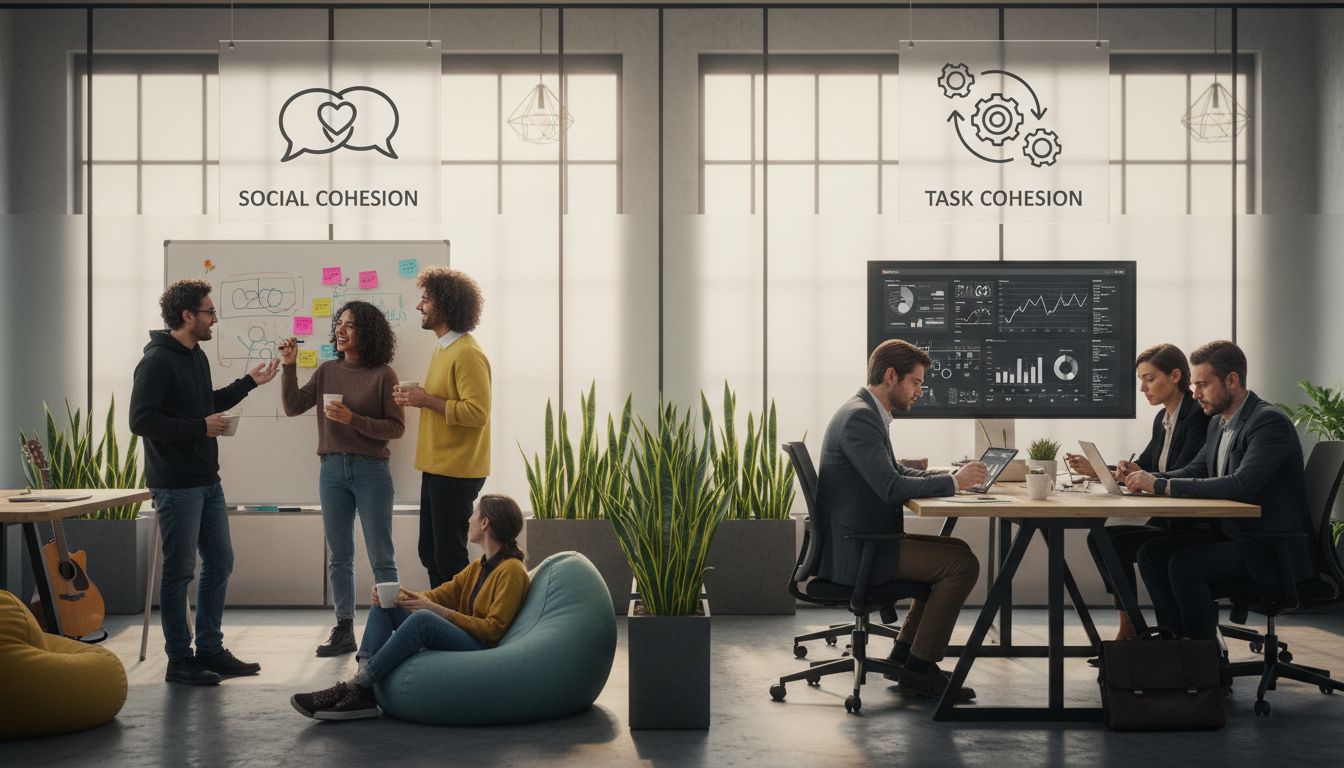Fostering Team Cohesion: Complete Expert Guide
October 24, 2025
Over sixty percent of high-performing teams report strong bonds are the secret to their success. In many workplaces, a group can easily drift into silos without clear connections or trust. True team cohesion shapes how people collaborate, solve problems, and feel motivated every day. With the right insights, teams can tap into shared strengths, overcome obstacles, and achieve results that exceed individual efforts.
Table of Contents
- Defining Team Cohesion And Core Concepts
- Key Drivers And Types Of Team Cohesion
- Practical Strategies For Building Cohesion
- Role Of Interactive Team-Building Games
- Common Challenges And Pitfalls To Avoid
Key Takeaways
| Point | Details |
|---|---|
| Team Cohesion Importance | Team cohesion is vital for transforming individuals into a synchronized, high-performing unit with mutual trust and shared objectives. |
| Types of Cohesion | Social and task cohesion are crucial components, influencing team dynamics and overall performance through emotional connections and commitment to goals. |
| Building Strategies | Intentional strategies like defining roles, promoting interdependence, and establishing common goals are essential for fostering strong team cohesion. |
| Challenges to Address | Proactively identifying and addressing challenges like communication breakdowns and resource hoarding is necessary for maintaining team cohesion and enhancing performance. |
Defining Team Cohesion and Core Concepts
Team cohesion represents the intricate psychological and emotional bonds that connect team members, transforming a group of individuals into a unified, synchronized workforce. According to research from the University of Minnesota, team cohesion encompasses more than just working together—it involves interpersonal attraction, shared identity, and collective commitment to achieving team objectives.
At its core, team cohesion is about creating an environment where team members feel deeply connected, trusted, and psychologically safe. Understanding Team Dynamics Explained: Key Concepts Revealed highlights that this connection goes beyond mere professional interactions. Key elements of strong team cohesion include:
- Mutual trust and respect
- Open and transparent communication
- Shared goals and vision
- Emotional investment in team success
- Willingness to support fellow team members
Research indicates that cohesive teams demonstrate significantly higher performance levels, with members who are more engaged, motivated, and committed to collective outcomes. When team members feel a genuine sense of belonging, they're more likely to collaborate effectively, share knowledge, and navigate challenges together. Ultimately, team cohesion transforms a group of individual contributors into a powerful, synchronized unit capable of achieving extraordinary results.
Key Drivers and Types of Team Cohesion
Team cohesion isn't a one-dimensional concept, but a nuanced framework with distinct types and critical drivers that shape team dynamics. According to research from HR Lineup, team cohesion is fundamentally driven by several interconnected factors that create a robust and high-performing team environment.
Two primary types of team cohesion emerge as critical for organizational success: social cohesion and task cohesion. Understanding Building Team Cohesion Explained suggests that these types work in tandem to create powerful team synergy. Social cohesion focuses on the emotional connections and interpersonal relationships between team members, while task cohesion centers on the shared commitment to achieving collective objectives.
Here's a comparison of the two primary types of team cohesion:
| Type of Cohesion | Focus Area | Key Benefits |
|---|---|---|
| Social Cohesion | Emotional bonds Interpersonal relationships | Higher trust Positive atmosphere Team satisfaction |
| Task Cohesion | Shared objectives Commitment to goals | Increased productivity Effective collaboration Goal alignment |
The key drivers of team cohesion are multifaceted and interconnected:
- Trust: The foundational element that enables open communication
- Effective Communication: Transparent and honest dialogue
- Mutual Respect: Valuing each team member's contributions
- Shared Goals: A unified vision that aligns individual efforts
- Collaborative Environment: Encouraging collective problem-solving
Research indicates that teams successfully balancing social and task cohesion demonstrate significantly higher performance, engagement, and resilience. By cultivating these drivers and understanding the nuanced types of cohesion, organizations can create adaptive, motivated teams capable of navigating complex challenges with remarkable synergy and collective intelligence.

Practical Strategies for Building Cohesion
Building team cohesion requires intentional, strategic approaches that go beyond simple interactions. According to research from the University of Wisconsin-Stout, team cohesion is not an accidental outcome but a deliberate process involving carefully designed interventions and thoughtful organizational practices.
Effective team cohesion strategies focus on creating an environment that naturally encourages collaboration and mutual understanding. Complete Guide to Successful Team-Building Tips emphasizes the importance of structured activities that help teams develop stronger interpersonal connections and aligned objectives. These strategies typically involve:
- Defining Clear Roles: Establishing precise responsibilities for each team member
- Promoting Interdependence: Designing tasks that require collaborative effort
- Establishing Common Goals: Creating unified objectives that transcend individual contributions
- Encouraging Regular Interaction: Facilitating meaningful communication opportunities
- Implementing Reward Systems: Recognizing collective achievements
Research indicates that successful team-building activities reduce role ambiguity and enhance social relations by creating shared experiences. By systematically implementing these strategies, organizations can transform individual contributors into high-performing, emotionally connected teams that are capable of navigating complex challenges with remarkable synergy and collective intelligence.
Role of Interactive Team-Building Games
Interactive team-building games represent a strategic approach to transforming workplace dynamics, moving beyond traditional training methods to create meaningful, engaging experiences that forge stronger team connections. According to research from Wikipedia, these interactive games are meticulously designed activities that expose interpersonal dynamics and address potential collaboration challenges.
10 Engaging Big Group Team Building Games for Success highlights the multifaceted benefits of these interactive experiences. By creating scenarios that require collective problem-solving, these games help teams develop critical skills such as:
- Communication: Enhancing verbal and non-verbal interaction skills
- Trust Building: Creating opportunities for genuine connections
- Role Clarification: Understanding individual strengths and team contributions
- Problem-Solving: Developing collaborative strategy and innovation
- Conflict Resolution: Learning to navigate challenges constructively
Research on high-performance teams indicates that interactive games are more than mere entertainment—they are powerful tools for developing complementary talents and aligning team members toward shared objectives. By transforming traditional team interactions into dynamic, playful experiences, organizations can create environments that naturally foster deeper understanding, mutual respect, and collective achievement.
Common Challenges and Pitfalls to Avoid
Team cohesion is a delicate ecosystem that can be easily disrupted by seemingly minor organizational and interpersonal challenges. According to research from HR LineUp, team challenges often emerge from complex interactions that, if left unaddressed, can significantly undermine collective performance and team spirit.
How to Customize Team Games for Enhanced Collaboration emphasizes the importance of proactively identifying and addressing potential team dysfunction. The most common challenges that teams encounter include:
- Communication Breakdown: Misunderstandings and unclear messaging
- Resource Hoarding: Reluctance to share knowledge or tools
- Blame Culture: Shifting responsibility during failures
- Silo Mentality: Working in isolation instead of collaboratively
- High Absenteeism: Inconsistent team member engagement
Research from Wikipedia highlights that effective team building requires more than recognizing these challenges—it demands strategic intervention. By creating transparent communication channels, establishing clear goals, and fostering a culture of mutual accountability, organizations can transform potential pitfalls into opportunities for growth, turning internal friction into a catalyst for enhanced team performance and collective resilience.
Strengthen Your Team Cohesion with Interactive Quiz Games
Building trust and clear communication are key to overcoming challenges like poor collaboration or role ambiguity mentioned in the "Fostering Team Cohesion" guide. When teams share engaging experiences that promote mutual respect, shared goals, and open dialogue, they achieve lasting connection and productivity. Our platform offers the perfect solution by combining entertaining, customizable quiz games designed to boost both social and task cohesion.

Experience how interactive team-building games transform your team dynamics. Take control with our flexible software allowing you to tailor quizzes to your team’s unique needs. Whether online or in-person, quizado.com helps you create an environment where collaboration flourishes, and every member feels valued. Start fostering deeper connections today by visiting quizado.com and discover how to customize team games for enhanced collaboration. The key to cohesive, high-performing teams is closer than you think.
Frequently Asked Questions
What is team cohesion and why is it important?
Team cohesion refers to the psychological and emotional bonds that connect team members, leading to a more unified and effective workforce. It is important because cohesive teams demonstrate higher performance levels, increased engagement, and a stronger commitment to collective objectives.
What are the key drivers of team cohesion?
Key drivers of team cohesion include trust, effective communication, mutual respect, shared goals, and a collaborative environment. These factors help create a supportive atmosphere that encourages teamwork and engagement.
What are some effective strategies for building team cohesion?
Effective strategies for building team cohesion include defining clear roles for team members, promoting interdependence through collaborative tasks, establishing common goals, encouraging regular interactions, and implementing reward systems for collective achievements.
How do interactive team-building games enhance team cohesion?
Interactive team-building games enhance team cohesion by fostering communication, trust, and problem-solving skills. These games create opportunities for team members to connect more deeply, clarify individual roles, and learn how to navigate challenges together.



